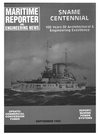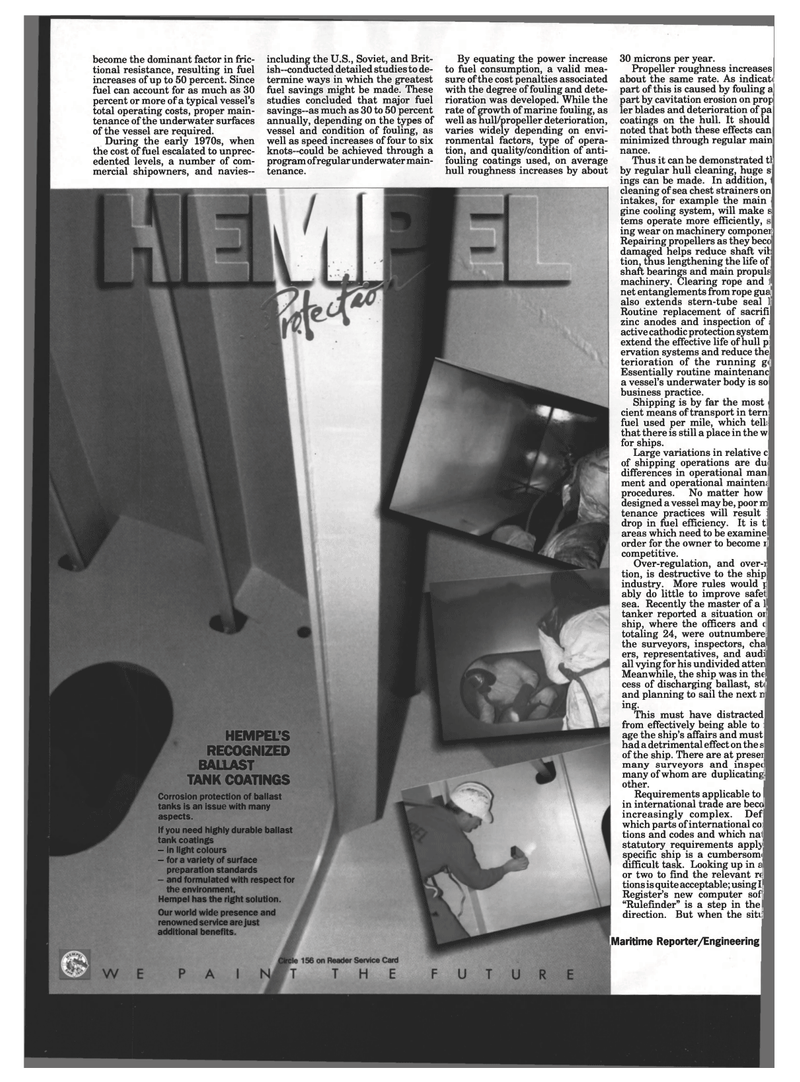
Page 38: of Maritime Reporter Magazine (September 1993)
Read this page in Pdf, Flash or Html5 edition of September 1993 Maritime Reporter Magazine
become the dominant factor in frac- tional resistance, resulting in fuel increases of up to 50 percent. Since fuel can account for as much as 30 percent or more of a typical vessel's total operating costs, proper main- tenance of the underwater surfaces of the vessel are required.
During the early 1970s, when the cost of fuel escalated to unprec- edented levels, a number of com- mercial shipowners, and navies- including the U.S., Soviet, and Brit- ish~conducted detailed studies to de- termine ways in which the greatest fuel savings might be made. These studies concluded that major fuel savings~as much as 30 to 50 percent annually, depending on the types of vessel and condition of fouling, as well as speed increases of four to six knots-could be achieved through a program of regular underwater main- tenance.
By equating the power increase to fuel consumption, a valid mea- sure of the cost penalties associated with the degree of fouling and dete- rioration was developed. While the rate of growth of marine fouling, as well as hull/propeller deterioration, varies widely depending on envi- ronmental factors, type of opera- tion, and quality/condition of anti- fouling coatings used, on average hull roughness increases by about
HEMPEL'S
RECOGNIZED
BALLAST
TANK COATINGS
Corrosion protection of ballast tanks is an issue with many aspects.
If you need highly durable ballast tank coatings — in light colours — for a variety of surface preparation standards — and formulated with respect for the environment,
Hempel has the right solution.
Our world wide presence and renowned service are just additional benefits. 30 microns per year.
Propeller roughness increases about the same rate. As indicat< part of this is caused by fouling a part by cavitation erosion on prop ler blades and deterioration of pa coatings on the hull. It should noted that both these effects can minimized through regular main nance.
Thus it can be demonstrated tl by regular hull cleaning, huge s ings can be made. In addition, cleaning of sea chest strainers on intakes, for example the main gine cooling system, will make s tems operate more efficiently, ing wear on machinery componeil
Repairing propellers as they beco damaged helps reduce shaft vifc tion, thus lengthening the life of shaft bearings and main propuls machinery. Clearing rope and j net entanglements from rope gua| also extends stern-tube seal 1
Routine replacement of sacrifi zinc anodes and inspection of active cathodic protection system extend the effective life of hull p: ervation systems and reduce the terioration of the running g<|
Essentially routine maintenanc a vessel's underwater body is so business practice.
Shipping is by far the most cient means of transport in tern fuel used per mile, which telli that there is still a place in the w for ships.
Large variations in relative c of shipping operations are du differences in operational man ment and operational mainten;! procedures. No matter how designed a vessel maybe, poorm tenance practices will result : drop in fuel efficiency. It is tl areas which need to be examine order for the owner to become rl competitive.
Over-regulation, and over-i tion, is destructive to the ship industry. More rules would p ably do little to improve safetl sea. Recently the master of a ll tanker reported a situation or I ship, where the officers and cl totaling 24, were outnumberel the surveyors, inspectors, cha| ers, representatives, and audi all vying for his undivided atten
Meanwhile, the ship was in the cess of discharging ballast, st<| and planning to sail the next n ing.
This must have distracted from effectively being able to age the ship's affairs and must had a detrimental effect on the s of the ship. There are at preset many surveyors and inspec many of whom are duplicating] other.
Requirements applicable to in international trade are becol increasingly complex. Def which parts of international co: tions and codes and which nal statutory requirements apply specific ship is a cumbersomi difficult task. Looking up in a or two to find the relevant rd tions is quite acceptable; using 11
Register's new computer soft "Rulefinder" is a step in the direction. But when the sitd 40 Maritime Reporter/Engineering News

 37
37

 39
39
